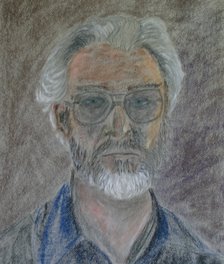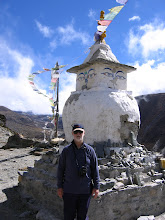After the unpleasant illness of the previous day, I woke up feeling much better and felt well enough to tackle a light breakfast and, later, a light lunch. I decided that I would be OK to travel on Friday so we headed back down into the city to the Akamba Bus Company to re-book. The booking agent apologised, unnecessarily, for not being able to give us a refund which, he explained, we could have got if we had notified them before our scheduled departure. However, he gave us new tickets for half price (Ks450 each) which was much appreciated.
On Friday we decided to do some more sightseeing to fill in the time before our long bus trip that night. We booked a four and a half hour guided trip through the Nairobi Game Park and were amply rewarded with sightings of many animals including Grant’s and Thompson’s Gazelle, Impala, Eland, Wildebeest, Hartebeest, Buffalo, Rhinoceros, Crocodiles, Tortoise, Baboons, Hyrax, Zebra, Giraffe. There were also many bird species to be seen and they included Ostrich, Maribou Stork, Vulture, Weaver Birds, Blacksmith Bird and Pigeons. We didn’t get to see any of the big cats but this was unsurprising as the grass was very tall – we could barely see the rhinos until we got fairly close.
After returning from our trip to the Game Park we checked out of the Fairview and went down to Lagos Road to catch our bus from Kampala. I’d heard about the chaos typically attending bus departures in Italy and what we experienced would not, it seems, have been out of place there. Nevertheless it all resolved and we departed for Kampala at 7:15pm. We discovered that two young Germans, Pierre and Till, who were on board the bus were also planning to do the Ruwenzori circuit so I suggested that we join forces giving us a party of four. I had the idea that the larger party would make guide and porter negotiations a bit easier and probably save all of us a bit of money. The only hitch from their point of view, discovered after we were well on the way, was that they had left the batteries for their camcorder charging in a friend’s room back in Nairobi. By the time we left Naivasha they had managed to contact the friend and arranged to meet up with him in Kampala the following day with the errant batteries.
The bus trip was generally neither more nor less of an experience than any other such long distance journey with the exception that the seat padding was almost non-existent. To stave off the numb-bum effect I pulled the dense foam stiffener from the inside of my day-pack and doubled that between my posterior and the seat. It provided some relief but about four times as thick would have been better. Dominic had no additional padding so was suffering far worse than I.
At the Kenya-Uganda border post of Busia we had a two hour delay while the various customs officials inspected all of the cargo in great detail. However, we had no problem with personal clearances. All of this around 2am.
Upon getting underway from Busia we had been travelling for perhaps an hour and a half before being stopped again for another check – this time by a militia group. We all had to get off the bus and were instructed to leave all belongings behind but we took our day-packs with us. All of the personal gear left on board was searched and the odd bottle of beer was ‘confiscated’ before finally we were allowed back on the bus to continue our journey. Eventually, we arrived in Kampala at 11am after 16 hours of travel – 14 of them bum-numbing.
The journey from Busia to Kampala gave us a view of the Eastern Uganda countryside which proved quite different to the drier conditions we had experienced in Kenya. Seen from the bus it seemed to be very lush and green with lots of trees. Tea plantations were frequent and the towns and villages we passed through were in better condition than their Kenyan counterparts. Uganda went through a lot of turmoil after independence in 1962. Its first president, Milton Obote was ousted by Idi Amin in 1971 and then returned from exile for a second period in 1979 after Amin was ousted by Tanzanian forces. Obote’s second term was marked by repression and eventually he was ousted for the second time by his own military chiefs in a coup in 1985. After a period of unrest the (guerrilla) National Resistance Army of the current President Museveni took control. However, Uganda seemed to have weathered through and maintained its right to Winston Churchill’s appellation ‘Pearl of Africa’.
On arrival in Kampala Dominic and my priority was to locate a bus departing for Kasese in Western Uganda. Kasese is the jumping off point for the Ruwenzori trek and we wanted to get there as soon as possible so that we could get a trip organised. Pierre and Till were to wait in Kampala for their friend and follow on to Kasese the following day. Fortunately, in common with many other African cities, Kampala buses tend to congregate in a central area close to the city centre, markets, etc so we didn’t anticipate a long search and so it proved to be. Pierre and Till stayed with us until we located the general area from which buses departed for Kasese. We located a bus departing almost straight away costing us Us7000 each plus Us3000 for luggage. With the exchange rate at around Us (Uganda Shillings) 950 to 1000 for US$1 it was a very reasonable deal. The people all seemed to be very friendly and with much less of the pushiness of the Kenyans.
The bus was crowded and we would have to endure some more bum-numbing but at least we had a seat. During the six-hour trip we saw a strong and vibrant countryside with cultivated crops of coffee, tea, sugar cane and bananas. The early part of the trip was through relatively lush areas but later on, as we started across the western plains it became much drier. At one village some of the guys on the bus bought a big hand of about 15 bananas for Us200 – approximately 20c US.
Further on we saw many Impala and Bufffalo, along with baboons and a larger gazelle in the distance – possibly Eland. One of our fellow passengers was very eager to point out all of the animals to us. It is remarkable that the animal numbers have grown so much as a large percentage were killed off during the Tanzanian invasion when the soldiers would just gun them down indiscriminately – not even using them for food.
On arrival in Kasese we were absolutely filthy and sweaty and tired after about 23 hours travelling. We got a double room at the SAAD Hotel for Us15000 a night but no running water despite all the plumbing being in place. We had to make do with a 40 litre jerry can but it was better than no water at all. While waiting here for Pierre and Til, who should arrive the following day, we would search out the Ruwenzori Mountain Society to find out what was happening.
There were lots of Maribou storks around the hotel and the streets of the town. These are primarily carrion eaters so we guessed it was their job to keep the town clean up to a point. Dinner was of very tough chicken which we thought might actually be ‘leg of Maribou Stork’. The hotel is Muslim owned and therefore dry but that was no problem to us. It also meant that there was no bar noise to interfere with our rest. After dinner we walked around the town to see if we could find the RMS but without any luck.
 We had left John Matte Hut at around 9:10am and arrived at Bujuku Hut ahead of the Dutch party at around 4pm. Along the way we met up with the two British guys again as they were on their way back down to spend the night at John Matte Hut again. Just at the time we met up with them, which would have been mid-afternoon, the clouds lifted and we got a rare glimpse of the high peaks. Sightings are rare as they are frequently shrouded in cloud so we felt quite priviledged. The photo at left shows Bert admiring the sights near Lake Bujuku with giant Lobelia and giant Groundsel in the background.
We had left John Matte Hut at around 9:10am and arrived at Bujuku Hut ahead of the Dutch party at around 4pm. Along the way we met up with the two British guys again as they were on their way back down to spend the night at John Matte Hut again. Just at the time we met up with them, which would have been mid-afternoon, the clouds lifted and we got a rare glimpse of the high peaks. Sightings are rare as they are frequently shrouded in cloud so we felt quite priviledged. The photo at left shows Bert admiring the sights near Lake Bujuku with giant Lobelia and giant Groundsel in the background.











